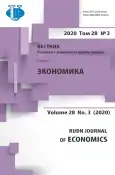China’s AI experience: industrial digitalization
- 作者: Reshetnikova M.S.1
-
隶属关系:
- Peoples’ Friendship University of Russia (RUDN University)
- 期: 卷 28, 编号 3 (2020)
- 页面: 536-546
- 栏目: INNOVATIONS IN THE MODERN ECONOMY
- URL: https://journal-vniispk.ru/2313-2329/article/view/324137
- DOI: https://doi.org/10.22363/2313-2329-2020-28-3-536-546
- ID: 324137
如何引用文章
全文:
详细
The rapid acceleration of scientific and technological progress, which started at the beginning of the 21st century, has become a decisive factor in influencing the global economy. Who will lead the global innovation race? This problem is especially relevant in the field of artificial intelligence (AI). At the moment, the United States and China are the main participants in the battle for dominance in this area. The author assesses China’s innovative potential in the field of AI and identifies its achievements in this area. Based on the statistics provided, China’s AI leadership has reached a critical point. China is confidently leading the new fundamental research of artificial intelligence, forming its theoretical base and applied research and development, which will contribute to the creation of new high-tech innovative products and services. However, in terms of the number and quality of AI specialists (AI Talents) and the number of companies engaged in AI, China is still lagging behind its main rival, namely the United States. The author proved that, despite the obvious successes of China, the United States still has an equal lead in the global innovation race.
作者简介
Marina Reshetnikova
Peoples’ Friendship University of Russia (RUDN University)
编辑信件的主要联系方式.
Email: reshetnikova-ms@rudn.ru
PhD, Associate Professor of the Economic and Mathematic Modelling Department at Economic Faculty
6 Miklukho-Makalay St, Moscow, 117198, Russian Federation参考
- AAAI Conferences. (2020). Retrieved February 12, 2020, from http://www.aaai.org/Conferences/ conferences.php
- Artificial intelligence: Implications for China. (2020). Retrieved February 12, 2020, from https:// www.mckinsey.com/featured-insights/china/artificial-intelligence-implications-for-china
- Association for the Advancement of Artificial Intelligence. (2020). Retrieved February 12, 2020, from https://www.aaai.org/
- Băzăvan, A. (2019). Chinese government’s shifting role in the national innovation system. Technological Forecasting and Social Change, 148, 119738. doi: 10.1016/j.techfore. 2019.119738.
- Bitzinger, R., & Raska, M. (2020). Capacity for Innovation: Technological Drivers of China’s Future Military Modernization. The PLA in the 2025. Retrieved February 12, 2020, from https://www.rsis.edu.sg/staff-publication/641-capacity-for-innovation-te/
- Bostrom, N. (2017). Superintelligence (pp. 176-180). Oxford: Oxford University Press.
- CB INSIGHTS. (n.d.). The 2018 Global CVC Report 2019. Retrieved January 24, 2020, from https://www.cbinsights.com/research/report/corporate-venture-capital-trends-2018/
- China AI Development Report. (2020). Retrieved February 12, 2020, from http://www.sppm. tsinghua.edu.cn/eWebEditor/UploadFile/Executive_susmmary_China_AI_Report_2018.pdf
- China National Bureau of Statistics (CNBS). (2019). China Statistical Yearbook. Beijing: China Statistical Press.
- Ding, J. (2018). Deciphering China’s AI Dream. The context, components, capabilities, and consequences of China’s strategy to lead the world in AI. Retrieved February 8, 2020, from https://www.fhi.ox.ac.uk/wp-content/uploads/Deciphering_Chinas_AI-Dream.pdf
- Elstrom, P. (2020). Are you a robot? Bloomberg. Retrieved January 20, 2020, from https://www.bloomberg.com/news/articles/2019-07-09/china-s-venture-capital-boomshows-signs-of-turning-into-a-bust
- Fukuyama, F. (2011). Falling behind. New York: Oxford University Press. iiMedia Research Group. (2020). Retrieved February 12, 2020, from http://www.iimedia.com.cn/en/
- Lai, Y., & Vonortas, N. (2019). Regional entrepreneurial ecosystems in China. Industrial and Corporate Change, 28(4), 875-897. doi: 10.1093/icc/dtz035
- Lee, K. (2018). AI Superpowers (p. 272). Houghton Mifflin Harcourt
- Liu, P., & Bell, R. (2019). Exploration of the initiation and process of business model innovation of successful Chinese ICT enterprises. Journal of Entrepreneurship in Emerging Economies, 11(4), 515-536. doi: 10.1108/jeee-09-2018-0094
- Ma, G., Roberts, I., & Kelly, G. (2017). Rebalancing China's Economy: Domestic and International Implications. China & World Economy, 25(1), 1-31. doi: 10.1111/cwe.12184.
- Qiao, Z., & Li, Z. (2018). Do foreign institutional investors enhance firm innovation in China? Applied Economics Letters, 26(13), 1125-1128. doi: 10.1080/13504851.2018.1540831.
- Reshetnikova, M. (2018). Innovation and Entrepreneurship in China. European Research Studies Journal, XXI(3), 506-515. doi: 10.35808/ersj/1079.
- Rowley, J. (2020). Chinese Startups Net Smallest Share of Global VC Investment in Years. Retrieved January 10, 2020, from https://news.crunchbase.com/news/chinese-startupsnet-smallest-share-of-global-vc-investment-in-years/
- Sun Hung Kai Properties. (2020). Financial Results & Reports. Retrieved February 12, 2020, from https://www.shkp.com/en-US/investor-relations/financial-results-reports
- The 2018 Survey: AI and the Future of Humans. (2020). Retrieved February 6, 2020, from http://www.elon.edu/eweb/imagining/surveys/2018_survey/AI_and_the_Future_of_Humans.xhtml
- Wagner, H. (2019). On the (Non-)sustainability of China’s Development Strategies. The Chinese Economy, 52(1), 1-23. doi: 10.1080/10971475.2019.1580822.
- WIPO Technology Trends 2019 - Artificial Intelligence. (2020). Retrieved February 12, 2020, from https://www.wipo.int/publications/en/details.jsp?id=4386
- World Internet Development Report 2019. (2020). Retrieved February 12, 2020, from http://www.wuzhenwic.org/2019-10/20/c_418499.htm
- Zhan, F., Proelss, J., & Schweizer, D. (2020). China: From imitator to innovator? Emerging Markets Review, 100675. doi: 10.1016/j.ememar.2019.100675.
补充文件









